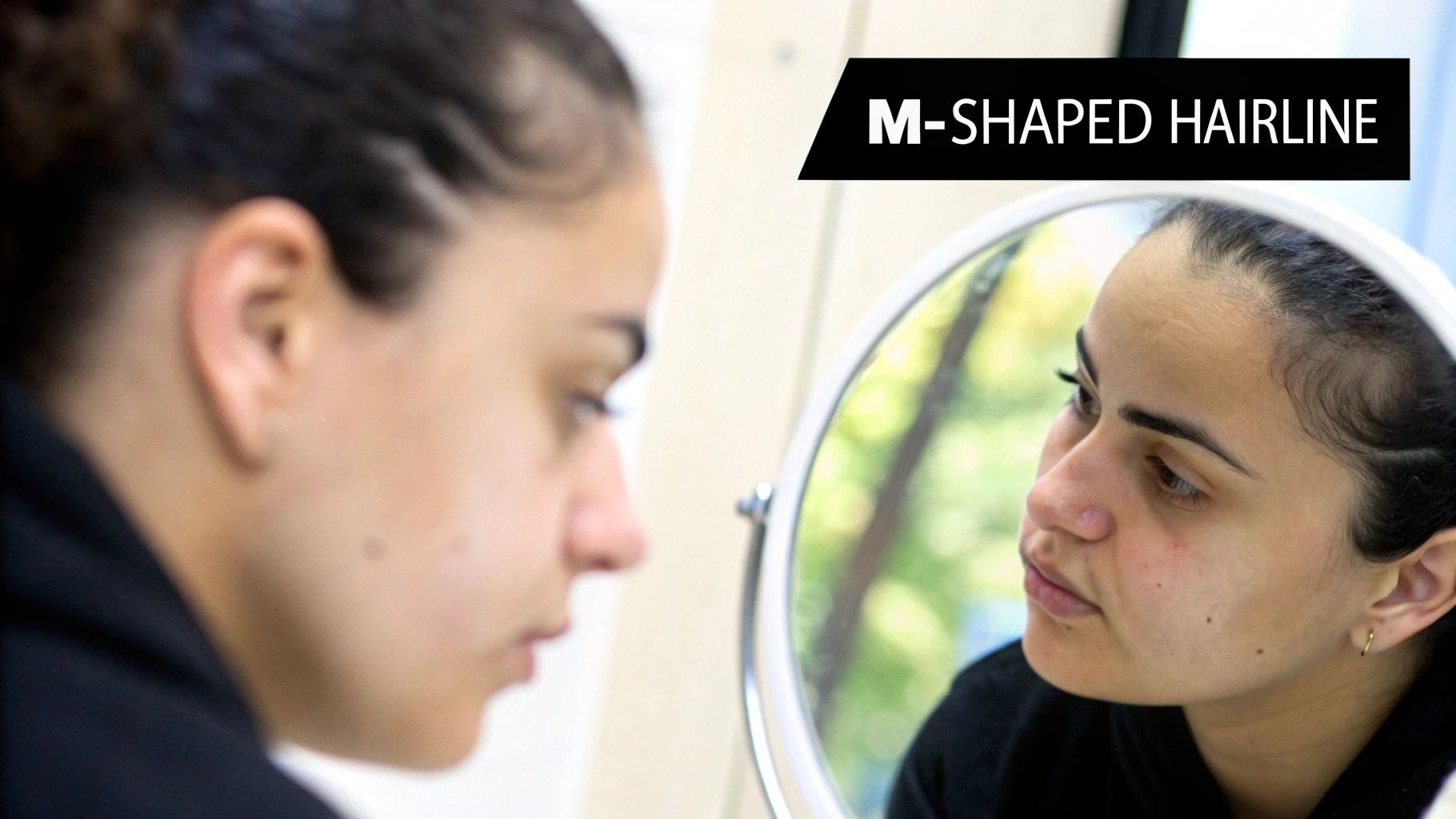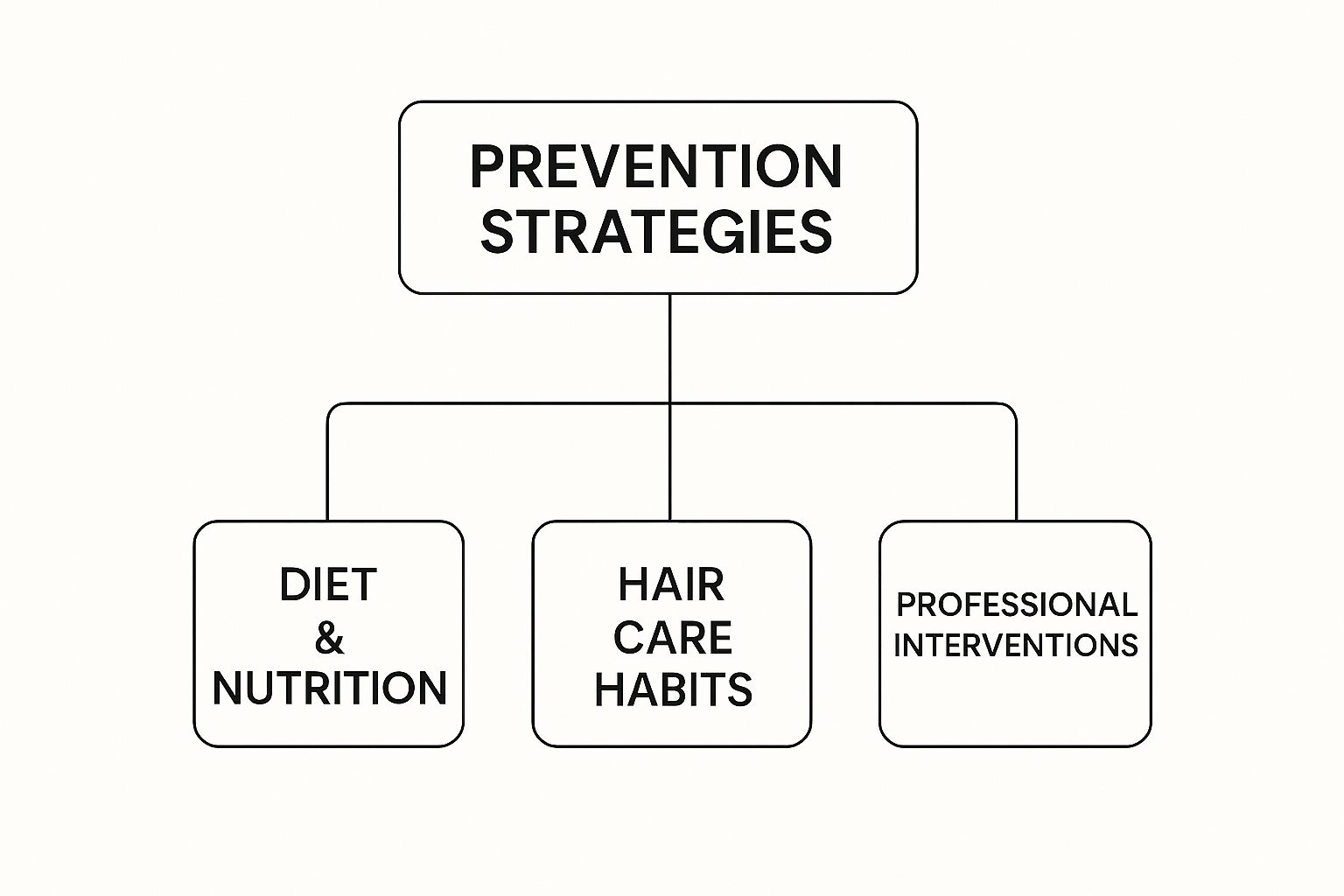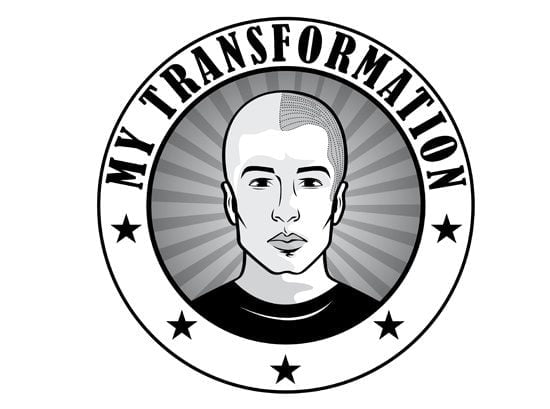
Fix Your M Shaped Hairline: Expert Tips & Treatments in Australia
Share
An M-shaped hairline is simply a pattern where the hair at your temples starts to recede, leaving a peak in the middle. It’s a classic look that often marks the first step toward a more mature hairline or, for some, the beginning of male pattern baldness. But it's definitely not something to panic about straight away. Most of the time, this change is just a natural part of ageing and genetics doing their thing.
What an M Shaped Hairline Really Means

Watching your hairline change can be a bit confronting. It helps to stop thinking of it as a fixed line etched in stone and more like something that naturally evolves as you get older. An M-shaped hairline is just one of the ways this evolution can look, with the corners receding more than the hair in the centre of your forehead.
The goal of this guide is to pull back the curtain on this whole process. We want to give you the knowledge and practical solutions you need to feel confident.
For a lot of guys, this pattern is completely normal. It might just be a "mature hairline" that appears in your late teens or early twenties and then stays put for decades. For others, it can be the first sign of more significant hair loss—a journey that is incredibly common.
A Common Experience in Australia
Down here in Australia, seeing an M-shaped hairline develop is far from unusual. It’s one of the most common ways male pattern baldness starts, and it affects a huge number of Aussie blokes.
Research shows that by the time they hit 50, around 30% to 50% of Australian men are dealing with some degree of androgenetic alopecia (the clinical term for it). This often kicks off in a guy’s 20s, and family history is a massive factor—about 80% of men experiencing hair loss can thank their genes. The main culprit is a hormone called dihydrotestosterone (DHT), which shrinks the hair follicles and leads to that classic M-shape.
What This Guide Covers
In this guide, we're going to walk you through everything you need to know about navigating life with an M-shaped hairline. Our aim is to give you clear, straightforward information so you feel like you're in the driver's seat.
Here’s a taste of what we’ll get into:
- The Science Behind It: We’ll break down the main causes, zeroing in on the roles that genetics and hormones play.
- Identifying Your Stage: You'll learn how to figure out where you're at using a simplified version of the Norwood scale, the go-to tool for tracking hair loss progression.
- Styling and Treatment Options: We’ll cover everything from hairstyles that work with your new look to effective treatments like Scalp Micropigmentation (SMP), available right here in Australia.
Understanding What’s Behind Your Receding Hairline
When you first notice your hairline changing shape, it’s easy to wonder what’s going on. But this process isn’t random. There’s a specific biological story unfolding, and it has two main characters: your genes and your hormones.
Think of your genes as the architectural blueprint for your hair. This plan, passed down through your family, holds all the instructions—including whether you're predisposed to hair loss and what pattern it might follow, like the classic m shaped hairline.
But a blueprint just sits there until someone starts building. That's where hormones come into play.
The Role of Genetics and Hormones
The main hormone that brings this genetic blueprint to life is Dihydrotestosterone (DHT). DHT is a potent androgen, a byproduct of testosterone, and it's the catalyst that kicks off hair loss in anyone who is genetically wired for it.
Here’s how it works: DHT latches onto receptors in your hair follicles. Over time, this connection causes the follicles to shrink, a process known as miniaturisation. As the follicles get smaller, the hair they produce becomes finer, shorter, and weaker. Eventually, they stop growing hair altogether. This systematic shrinking is exactly what causes the hairline to slowly recede at the temples.
To get a deeper understanding of the science, check out our detailed guide on what causes male pattern baldness.
Your Family History Is a Major Clue
You really can't overstate the influence of your family tree when it comes to predicting how your hairline will change. Genetics are the single biggest factor in determining if and when androgenetic alopecia will show up.
Research on Australian men revealed something pretty stark: those with bald fathers are about five times more likely to develop male pattern baldness themselves. This shows just how strong the hereditary link is and how much your genes dictate your hairline's future.
And it's not just your dad's side you need to look at. Studies also show that your mother's family history contributes significantly, so it’s a trait you can inherit from either parent. For women, early-onset hair loss also has strong hereditary links, with a large percentage of affected women reporting a family history of it. You can find more detail on these familial risk findings on ncbi.nlm.nih.gov.
Ultimately, understanding that it's a mix of your inherited genes and the hormonal trigger of DHT can take the mystery out of the whole thing. It’s not about something you’ve done wrong; it’s simply your body following a predetermined script. Knowing this is the first step toward making confident, informed decisions about how to manage your hairline.
Navigating Hairline Changes for Women

While the conversation around an M-shaped hairline usually focuses on men, it's a reality many Australian women navigate too. But for women, a receding hairline often looks and feels different. Instead of that distinct 'M' shape, you’re more likely to see a gradual, diffuse thinning around the temples and along the front of your hairline.
This kind of change is often tied to what’s known as Female Pattern Hair Loss (FPHL). It’s usually a mix of genetics, hormonal shifts, and other underlying health factors. Major life events like menopause, pregnancy, or even thyroid imbalances can trigger or worsen it, making each woman's experience completely unique.
The emotional toll of watching your hair change can be huge. The first, and most important, step is simply acknowledging what's happening. From there, you can start exploring solutions that help restore not just your hair, but your confidence as well.
Understanding Female Hairline Recession
You might be surprised to learn just how common FPHL is in Australia. It affects an estimated 49% of women at some point in their lives. And yes, while it's talked about less, women absolutely can experience hairline recession that creates an M-like pattern, which happens as the hair thins out at the temples. The culprit is often the same hormonal mechanism that affects men: androgens like DHT shrinking the hair follicles.
One revealing Australian study found that 55.2% of the women surveyed had moderate recession at their temples. What’s really interesting, though, is that over half of these women didn't really see it as a medical or cosmetic issue at first. This points to a major gap in awareness when it comes to female hair loss. You can read the full findings on female pattern hair loss to get a deeper insight.
This disconnect highlights an important truth: what you're experiencing is a valid and common medical condition, not just a cosmetic issue. Recognising it as such is crucial for seeking effective support and treatment.
Key Differences in Women's Hair Loss
To find the right way forward, it helps to understand the unique ways hair loss shows up in women. It doesn't follow the predictable stages often seen in men; the patterns are quite different.
- Diffuse Thinning: Women tend to see a general thinning all over the scalp. This often becomes most obvious where you part your hair, as the part line appears wider.
- Frontal Hairline Preservation: In many cases, the very front of the hairline stays put. The thinning happens just behind it and around the temples, reducing overall density.
- Hormonal Complexity: The hormonal picture is more complicated than just DHT. Fluctuations in oestrogen and progesterone play a significant role, adding another layer to the issue.
Because the patterns and causes aren't the same, the solutions need to be different too. If you’ve started noticing changes in your hair's thickness or your hairline's shape, it's worth learning about what causes thinning hair in women to find the most effective path for you.
Figuring Out Where Your Hairline is At
Knowing exactly where you stand with your hair loss is the first real step toward taking control. It stops the second-guessing, sets realistic expectations, and helps you figure out which styling tricks or treatment options are actually right for you. Think of it as getting your bearings before you plan the rest of the journey.
The go-to system for professionals is the Norwood Scale, which maps out the typical stages of male pattern baldness. It gets pretty detailed with seven stages, but for our purposes, we can simplify the journey of an M-shaped hairline into a few key phases. This isn't about giving yourself a clinical diagnosis, but about getting a clear picture of what's happening up top.
To make this even clearer, here’s a quick rundown of the main stages you'll likely encounter, based on a simplified version of the Norwood Scale.
Stages of an M-Shaped Hairline (Simplified Norwood Scale)
| Stage | Visual Description | Key Characteristics |
|---|---|---|
| Stage 1 | The Mature Hairline | A slight, even recession across the whole hairline. It's moved up a touch from your teenage years, but still looks full. |
| Stage 2 | The Early M-Shape | The corners (temples) start to recede more noticeably than the centre, creating the first hint of an 'M'. |
| Stage 3 | The Defined M-Shape | The 'M' is now obvious. Recession at the temples is deep, leaving a distinct peak of hair in the middle. |
| Stage 4 | Advanced Recession | The temples continue to recede, and you might also notice thinning or a bald spot appearing on the crown (vertex). |
Seeing it laid out like this helps you pinpoint your current situation and understand what might come next, allowing you to make more informed decisions.
Stage 1: The Mature Hairline
This is usually the first hint that things are changing, and honestly, it's completely normal. It’s just a slight, even shift of your entire hairline, moving it about 1-2 cm higher up your forehead than where it was when you were a teenager.
Is this actually balding? Not really. For most blokes, this is just a standard part of getting older and doesn't automatically mean you're on the fast track to significant hair loss.
Stage 2: The Early M-Shape
Now we’re starting to see that classic M-shape take form. The recession at your temples starts to outpace the middle of your forehead, pulling the corners of your hairline back and creating the two upper points of the 'M'.
At this point, the hair loss is still pretty mild. You’ve got a ton of styling options, and it’s the perfect time to start thinking about preventative measures if you’re keen to slow things down.

As you can see, a solid game plan involves more than just one thing. It's about combining good lifestyle habits, smart hair care, and getting expert advice to build the best possible defence.
Stage 3: The Defined M-Shape
By the time you reach this stage, there’s no mistaking it—the M-shape is clear and well-defined. The recession at the temples has become quite significant, carving out deep triangular areas. The central peak of hair at the front usually stays pretty dense, which makes the 'M' stand out even more.
This is often the point where guys start actively looking for solutions. The old hairstyles just don't cut it anymore, and the contrast between your temples and the hair in the middle becomes hard to ignore.
Stage 4: Advanced Recession and Thinning
In the later stages, the hair loss pattern starts to expand. Not only does the recession at the temples keep pushing further back, but you might also start to see thinning or a bald spot forming on the crown (the very top-back of your head).
Over time, that M-shaped recession and the thinning crown can eventually meet up. This is what leads to the horseshoe pattern of hair that just runs around the sides and back of the head. Knowing which stage you’re in gives you a realistic launchpad for exploring everything from clever haircuts to highly effective treatments like Scalp Micropigmentation.
Finding a Hairstyle That Works for You

Watching your hairline change doesn't mean you have to start hiding your hair under a hat. The right hairstyle can make a massive difference, shifting what you might see as a weakness into a key feature of a sharp, deliberate look. The trick isn't to fight your M-shaped hairline but to find a cut that works with it.
Many guys make the mistake of trying to force their hair to cover the recessed temples, but this often just puts a spotlight on the very thing they're trying to hide. A much better approach is to work with the shape of your hairline. This usually means keeping the sides tighter while adding some texture or volume on top, creating a silhouette that feels more balanced. It’s all about clever distraction and smart styling.
When you embrace a style that fits your hairline, you radiate confidence and control. The goal is to own your look, making it obvious that your hairstyle is a conscious choice, not just a desperate attempt to cover something up.
Top Hairstyles for an M Shaped Hairline
Choosing the right cut comes down to understanding the basics of balance and texture. A skilled barber will know exactly how to shape a style to suit your unique hairline and head shape. Here are a few reliable options that almost always look great.
- The Crew Cut: This one is a timeless classic for good reason. Keeping the hair short all over minimises the contrast between the thicker hair in the middle and the finer hair at the temples, resulting in a clean, unified look.
- The Textured Crop: A fantastic modern style for an M-shaped hairline. The sides are kept short, leaving more length on top. This is then styled forward with plenty of texture for a slightly messy, fuller appearance that naturally softens the sharp lines of the hairline.
- The Slick Back: If you've got enough length to play with, slicking your hair back is a bold, confident move. Instead of hiding the hairline, it puts it on full display, creating a sleek and sophisticated style that looks sharp and intentional.
The secret to a great haircut with a receding hairline is making it look intentional. Whether it's a buzz cut or a textured style, confidence is the best accessory you can wear. A well-executed cut shows you're in charge of your look.
Styling Principles to Remember
Beyond the specific cut you choose, a few styling techniques can help you make the most of what you've got. Think of these as the essential tools in your daily grooming kit.
A little bit of product can go a long way. Using a matte paste or clay will add texture and volume without weighing your hair down or making it look greasy, which can often make thinning more noticeable. You can also direct your hair's volume and flow to create the illusion of density exactly where you want it most.
If you’re starting to think about longer-term solutions that go beyond daily styling, it's worth understanding the differences between options like scalp micropigmentation vs. hair toppers. This can help you figure out what kind of permanent fix might be right for you.
Once you’ve nailed a hairstyle that makes you feel good, make sure it looks its best in professional photos by checking out these expert professional headshot tips. A great cut deserves to be captured perfectly, showcasing your newfound confidence.
Exploring Your Treatment Options in Australia
If you've decided that simply styling your M-shaped hairline isn't cutting it anymore and you're ready to take action, it's time to look at the treatments available right here in Australia. The good news is there's a solid range of options, from things you can do at home every day to more advanced clinical procedures.
Figuring out what each one actually does is the key. Once you know that, you can find the right fit for your goals, your budget, and how much effort you want to put in. Let's break down the most effective paths you can take.
Medications and Topical Solutions
For many guys, the first port of call is usually an accessible treatment they can weave into their daily routine. These are generally aimed at putting the brakes on hair loss and, if you're lucky, encouraging a bit of new growth.
- Minoxidil (Topical): You've probably seen this marketed under brand names like Rogaine. It’s an over-the-counter foam or liquid you apply straight onto your scalp. The idea is that it boosts blood flow to the hair follicles, which helps keep them in their active growth phase for longer.
- Finasteride (Oral): This one is a prescription-only pill that gets to the hormonal root of the problem. It works by blocking the specific enzyme that turns testosterone into DHT—the hormone notorious for shrinking hair follicles and causing male pattern baldness.
It's worth noting that these medical treatments tend to work best when you catch the hair loss early. The catch? You have to stick with them long-term to keep seeing the benefits.
Advanced and Procedural Options
When you’re after a more permanent or noticeable change, that's where procedural treatments come in. These are done by trained professionals and can completely reshape the look of your hairline.
One non-surgical option that's become incredibly popular is Scalp Micropigmentation (SMP). Think of it as a highly sophisticated form of cosmetic tattooing. A skilled practitioner uses tiny, specialised needles to place pigment into the scalp, creating thousands of tiny dots that mimic the appearance of real hair follicles. To get a better sense of the results, you can learn more about how Scalp Micropigmentation in Australia builds the illusion of a full, strong hairline.
Of course, there's also the more traditional—and more invasive—option of a hair transplant. This is a surgical procedure where healthy, DHT-resistant hair follicles are taken from the back and sides of your head and transplanted to the thinning or receding areas at the front.
A key thing to remember with procedural treatments is matching the solution to your stage of hair loss. SMP is fantastic for creating density and defining a sharp hairline, whereas a transplant physically puts real hair back where it's gone.
Other treatments like microneedling are also gaining a lot of attention. If you're looking into that, it's really important to understand the debate around microneedling at home versus professional treatments to make sure you're being both safe and effective. At the end of the day, each approach has its own pros and cons, and the best choice really boils down to your individual circumstances.
Comparing M Shaped Hairline Treatment Options
Choosing the right path can feel a bit overwhelming, so let's lay it all out. This table compares some of the most popular treatments to give you a clearer picture of how they stack up against each other.
| Treatment Option | How It Works | Typical Cost (AU) | Best For |
|---|---|---|---|
| Minoxidil (Topical) | Stimulates follicles and improves blood flow to the scalp. | $30 - $60 per month | Early-stage hair loss and slowing down progression. |
| Finasteride (Oral) | Blocks the production of DHT, the hormone that causes hair loss. | $50 - $80 per month (prescription) | Men with mild to moderate male pattern baldness. |
| Scalp Micropigmentation (SMP) | A cosmetic tattoo that creates the illusion of hair follicles. | $1,500 - $4,000+ total | Creating density, restoring a defined hairline, and for those with significant thinning or who prefer a shaved look. |
| Hair Transplant (FUE/FUT) | Surgically moves healthy hair follicles to thinning areas. | $5,000 - $20,000+ per procedure | Those with significant hair loss but a stable donor area at the back/sides of the head. |
| Microneedling | Creates micro-injuries in the scalp to stimulate growth factors. | $250 - $600 per professional session | Complementing other treatments like Minoxidil; mild thinning. |
Ultimately, this table is a starting point. The best results often come from a frank discussion with a specialist who can properly assess your hair loss and recommend a tailored plan that works for you.
Got Questions? We've Got Answers
When you start looking into M-shaped hairlines, it's natural for questions to pop up. Let's tackle some of the most common ones to give you the clear, honest answers you're looking for.
Can You Reverse an M-Shaped Hairline Naturally?
To be blunt, if your M-shaped hairline is down to genetics, you can't completely reverse it with natural remedies alone. What you can do, however, is create the best possible environment for the hair you have. Think of it as supporting your hair's health from the inside out.
Things like a balanced diet packed with vitamins, getting a handle on stress, and avoiding harsh hair treatments can definitely improve the quality and strength of your existing hair. But for actual regrowth in those recessed areas, you'll almost always need to look at medical or cosmetic procedures. Natural methods are fantastic for support, but they aren't a cure for recession.
What Age Does an M-Shaped Hairline Usually Start?
There's really no single answer for this one—it's different for everyone. Some guys might notice the first signs of their temples receding in their late teens or early 20s. For many others, the change doesn't become obvious until they hit their 30s or 40s.
The biggest clue is usually in your family tree. The timing is almost always linked to your genetics, so looking at the hairlines of your father and grandfathers can give you a pretty good idea of what your own future might look like.
Is an M-Shaped Hairline Always a Sign of Balding?
Not at all. This is a really important distinction to make. Many men develop what's called a "mature hairline" as they transition out of their teens. This is just a slight, natural recession at the temples that creates a subtle M-shape and is a normal part of getting older.
A mature hairline usually finds its place and then stays put. An M-shaped hairline only becomes a sign of active balding—or androgenetic alopecia—when that recession keeps going. If you notice the "M" getting deeper and moving further back over time, that's when it's considered progressive hair loss.
Ready to take control of your hairline? At My Transformation, we specialise in Scalp Micropigmentation (SMP) to create the look of a full, strong hairline. Book a consultation today to discover how we can help you regain your confidence.
